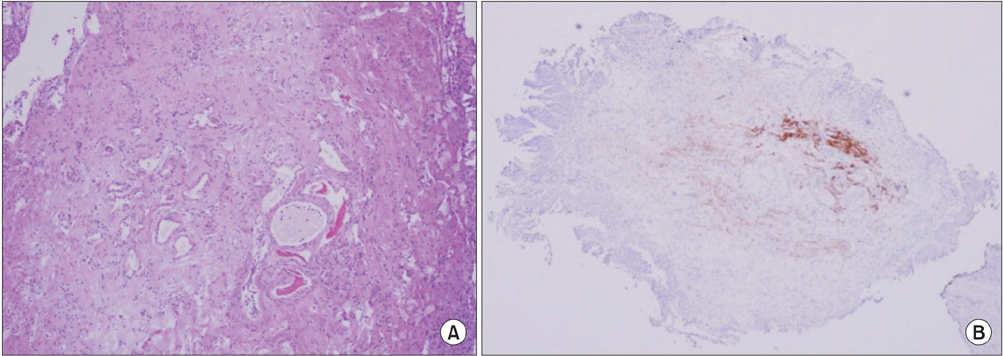Korean J Urol.
2015 Mar;56(3):227-232. 10.4111/kju.2015.56.3.227.
A novel transurethral resection technique for superficial flat bladder tumor: Grasp and bite technique
- Affiliations
-
- 1Department of Urology, Chonnam National University School of Medicine, Gwangju, Korea. sydad@hanmail.net
- 2Department of Pathology, Chonnam National University School of Medicine, Gwangju, Korea.
- KMID: 2133291
- DOI: http://doi.org/10.4111/kju.2015.56.3.227
Abstract
- PURPOSE
Transurethral resection of bladder tumor (TURBT) can be a challenging procedure for an inexperienced surgeon. We suggest an easy technique for TURBT, which we have named the "grasp and bite" technique. We describe this technique and compare its effectiveness and safety with that of conventional TURBT.
MATERIALS AND METHODS
Monopolar TURBT (24-Fr Karl Storz) was performed in 35 patients who had superficial bladder tumors. After defining the tumor margin, the tumor and surrounding mucosa were grasped by use of a loop electrode and resectoscope sheath. With tight grasping, linear moving resection was performed. The patients' demographic, intraoperative, and postoperative data were analyzed between the conventional and grasp and bite TURBT groups.
RESULTS
Of 35 patients, 16 patients underwent conventional TURBT (group 1), and the other 19 patients underwent grasp and bite TURBT (group 2). Both groups were similar in age, tumor multiplicity, size, anesthesia method, and location. Grasp and bite TURBT could be performed as safely and effectively as conventional TURBT. There were no significant differences in irrigation duration, urethral catheterization, postoperative hemoglobin drop, or length of hospital stay. No significant side effects such as bladder perforation, severe obturator reflex, or persistent bleeding occurred. There were no significant pathological differences between specimens according to the type of resection technique.
CONCLUSIONS
The grasp and bite TURBT technique was feasible for superficial bladder tumors. It may be a good tool for inexperienced surgeons owing to its convenient and easy manner.
MeSH Terms
Figure
Reference
-
1. Traxer O, Pasqui F, Gattegno B, Pearle MS. Technique and complications of transurethral surgery for bladder tumours. BJU Int. 2004; 94:492–496.2. McKiernan JM, Kaplan SA, Santarosa RP, Te AE, Sawczuk IS. Transurethral electrovaporization of bladder cancer. Urology. 1996; 48:207–210.3. Kihl B, Nilson AE, Pettersson S. Thigh adductor contraction during transurethral resection of bladder tumours: evaluation of inactive electrode placement and obturator nerve topography. Scand J Urol Nephrol. 1981; 15:121–125.4. Pantuck AJ, Baniel J, Kirkali Z, Klatte T, Zomorodian N, Yossepowitch O, et al. A novel resectoscope for transurethral resection of bladder tumors and the prostate. J Urol. 2007; 178:2331–2336.5. Maurice MJ, Vricella GJ, MacLennan G, Buehner P, Ponsky LE. Endoscopic snare resection of bladder tumors: evaluation of an alternative technique for bladder tumor resection. J Endourol. 2012; 26:614–617.6. Legrand G, Soliman H, Dubosq F, Verine J, Desgrandchamps F, de The H, et al. Prevalence and spectrum of microsatellite alterations in nonmuscle invasive bladder cancers. Am J Cancer Res. 2011; 1:595–603.7. Kurth KH, Denis L, Bouffioux C, Sylvester R, Debruyne FM, Pavone-Macaluso M, et al. Factors affecting recurrence and progression in superficial bladder tumours. Eur J Cancer. 1995; 31A:1840–1846.8. Wolters M, Kramer MW, Becker JU, Christgen M, Nagele U, Imkamp F, et al. Tm:YAG laser en bloc mucosectomy for accurate staging of primary bladder cancer: early experience. World J Urol. 2011; 29:429–432.9. Nagele U, Kugler M, Nicklas A, Merseburger AS, Walcher U, Mikuz G, et al. Waterjet hydrodissection: first experiences and short-term outcomes of a novel approach to bladder tumor resection. World J Urol. 2011; 29:423–427.10. Herr HW, Reuter VE. Evaluation of new resectoscope loop for transurethral resection of bladder tumors. J Urol. 1998; 159:2067–2068.11. Thomas K, O'Brien T. Improving transurethral resection of bladder tumour: the gold standard for diagnosis and treatment of bladder tumours. Eur Urol Suppl. 2008; 7:524–528.
- Full Text Links
- Actions
-
Cited
- CITED
-
- Close
- Share
- Similar articles
-
- Transurethral Resection Syndrome Caused by Bladder Perforation during Transurethral Resection of Bladder Tumor: A Report of 2 Cases
- Fluid extravasation caused by bladder perforation during bipolar transurethral resection using saline solution: a case report
- The Significance of Simultaneous Transurethral Resection of Bladder Tumor and the Prostate in Patient who have Superficial Bladder Cancer with Bladder Outlet Obstruction
- The Factors Influencing Prognosis of Superficial Bladder Tumor
- Prognostic Factors in Superficial Bladder Cancer: An Analysis of 178 Cases



